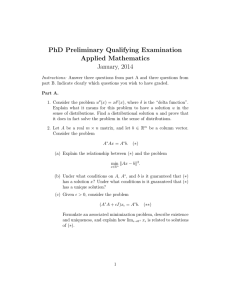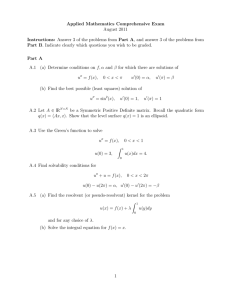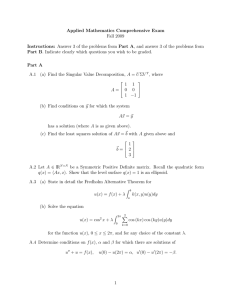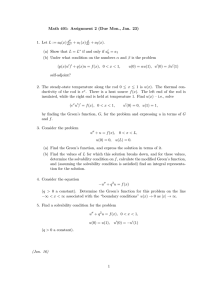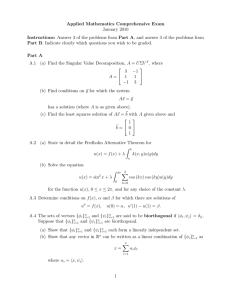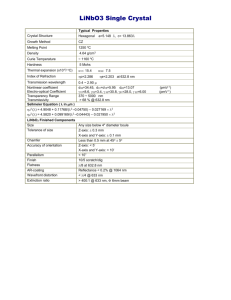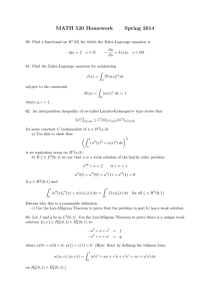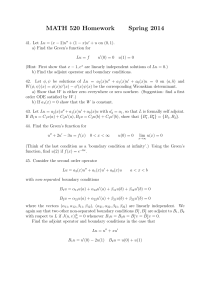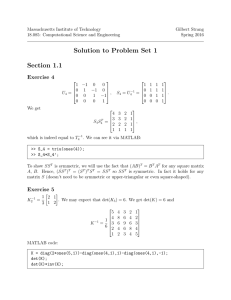Quantifying Cell-to-Cell Variation in Power-Law Rheology Please share
advertisement
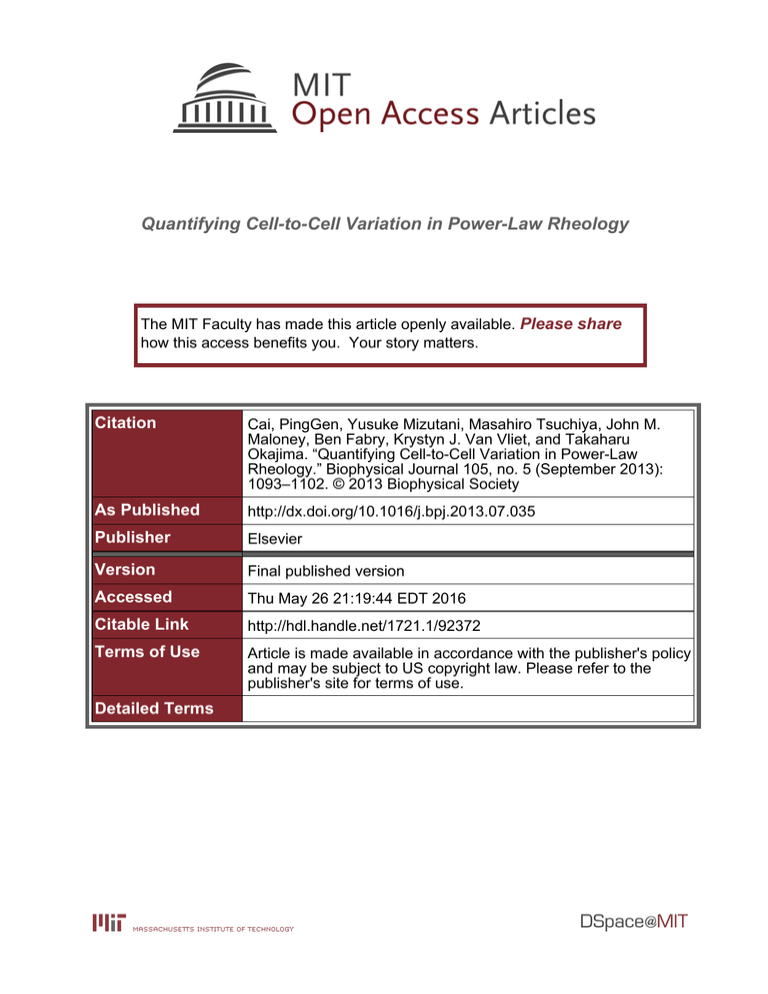
Quantifying Cell-to-Cell Variation in Power-Law Rheology
The MIT Faculty has made this article openly available. Please share
how this access benefits you. Your story matters.
Citation
Cai, PingGen, Yusuke Mizutani, Masahiro Tsuchiya, John M.
Maloney, Ben Fabry, Krystyn J. Van Vliet, and Takaharu
Okajima. “Quantifying Cell-to-Cell Variation in Power-Law
Rheology.” Biophysical Journal 105, no. 5 (September 2013):
1093–1102. © 2013 Biophysical Society
As Published
http://dx.doi.org/10.1016/j.bpj.2013.07.035
Publisher
Elsevier
Version
Final published version
Accessed
Thu May 26 21:19:44 EDT 2016
Citable Link
http://hdl.handle.net/1721.1/92372
Terms of Use
Article is made available in accordance with the publisher's policy
and may be subject to US copyright law. Please refer to the
publisher's site for terms of use.
Detailed Terms
Biophysical Journal Volume 105 September 2013 1093–1102
1093
Quantifying Cell-to-Cell Variation in Power-Law Rheology
PingGen Cai,† Yusuke Mizutani,† Masahiro Tsuchiya,† John M. Maloney,‡ Ben Fabry,§ Krystyn J. Van Vliet,‡{
and Takaharu Okajima†*
†
Graduate School of Information Science and Technology, Hokkaido University, Sapporo, Japan; ‡Department of Materials Science
and Engineering, Massachusetts Institute of Technology, Cambridge, Massachusetts; §Department of Physics, The University of
Erlangen-Nuremberg, Erlangen, Germany; and {Department of Biological Engineering, Massachusetts Institute of Technology,
Cambridge, Massachusetts
ABSTRACT Among individual cells of the same source and type, the complex shear modulus G exhibits a large log-normal
distribution that is the result of spatial, temporal, and intrinsic variations. Such large distributions complicate the statistical evaluation of pharmacological treatments and the comparison of different cell states. However, little is known about the characteristic
features of cell-to-cell variation. In this study, we investigated how this variation depends on the spatial location within the cell
and on the actin filament cytoskeleton, the organization of which strongly influences cell mechanics. By mechanically probing
fibroblasts arranged on a microarray, via atomic force microscopy, we observed that the standard deviation s of G was significantly reduced among cells in which actin filaments were depolymerized. The parameter s also exhibited a subcellular spatial
dependence. Based on our findings regarding the frequency dependence of s of the storage modulus G0 , we proposed two types
of cell-to-cell variation in G0 that arise from the purely elastic and the frequency-dependent components in terms of the soft
glassy rheology model of cell deformability. We concluded that the latter inherent cell-to-cell variation can be reduced greatly
by disrupting actin networks, by probing at locations within the cell nucleus boundaries distant from the cell center, and by
measuring at high loading frequencies.
INTRODUCTION
The living cell is a compliant, viscoelastic material with a
highly dynamic and continuously remodeling cytoskeleton
(CSK) (1–4). The rheological properties of adherent cells
are mainly attributed to the CSK and are related to various
cell functions (5–9). Studies have revealed that rheological
parameters as the creep compliance and the complex shear
modulus, G , which were measured at arbitrarily positions
of cells and/or spatially averaged, follow single (10–24)
or multiple (25–29) power-law behaviors over multiple
decades around 10 Hz.
On the other hand, the inherently heterogeneous CSK
structure results in spatial variation in cell elasticity
(30,31) and rheology (32) measurements. Recently, Park
et al. (33) investigated the local heterogeneity of the
ensemble-averaged shear modulus by measuring a large
number of single cells that were cultured on micropatterned
substrates. Using a single power-law rheology model
(15,16,34), they showed that in addition to the stiffness,
the power-law exponent and the Newtonian viscosity also
depend on the choice of subcellular region probed (33).
Moreover, previous studies have revealed universal features
of cell-to-cell mechanical variation: the number (ensemble)
distribution of G exhibits a log-normal distribution,
whereas the power-law exponent exhibits a normal, or
Gaussian, distribution (23–26,35). Furthermore, the distribution of G narrows as the frequency increases (35).
Phenomenological models to explain such a log-normal
Submitted February 6, 2013, and accepted for publication July 12, 2013.
*Correspondence: okajima@ist.hokudai.ac.jp
Editor: Jeffrey Fredberg.
Ó 2013 by the Biophysical Society
0006-3495/13/09/1093/10 $2.00
distribution and/or a frequency-dependent distribution
have been proposed (23,36), but the source of the observed
cell-to-cell variation remains poorly understood.
To address these questions, we investigated the ensemble
distribution of G versus frequency f using atomic force
microscopy (AFM)-enabled loading of individual mouse
fibroblast cells arranged on a microarray substrate (35,37).
Actin filament structures were found to play a strong role
in changing the frequency dependence of the ensemble
distribution of G . Moreover, the standard deviation of
the log-normal distribution varied depending on the measurement location on the cells. We discuss the inherent
cell-to-cell variation of the cell samples observed by
AFM, in terms of power-law rheology.
MATERIALS AND METHODS
Cell samples
Mouse fibroblast NIH3T3 cells (ATCC, Manassas, VA) were cultured at
37 C and 5% CO2 atmosphere for 12 days in Dulbecco’s modified Eagle’s
medium DMEM (Sigma-Aldrich, St. Louis, MO) containing penicillin (100
units/mL), streptomycin (100 mg/mL) (Sigma-Aldrich), and 10% fetal
bovine serum (FBS; HyClone, Logan, UT). After suspension with trypsin
(Sigma-Aldrich), cells were deposited in microarray wells of a hexagonal
shape and a width of 20 mm (LiveCell Array; Nunc, Penfield, NY) that
were first coated with fibronectin (BD Biosciences, San Jose, CA), in
complete medium (DMEM containing FBS) and immediately incubated
for 12 h under the same conditions as described previously. For AFM
measurements, the medium was replaced with CO2-independent medium
(Invitrogen, Carlsbad, CA). A fluorescence image of the nuclei of
NIH3T3 cells observed with a confocal optical microscope (DIGITAL
ECLIPSE C1; Nikon, Tokyo, Japan) is shown in Fig. 1 a. By staining nuclei
with DAPI, we confirmed that the average nucleus diameter was 10.7 mm
http://dx.doi.org/10.1016/j.bpj.2013.07.035
1094
Cai et al.
FIGURE 1 (a) Fluorescence image of nuclei of
NIH3T3 cells deposited in microarray wells and
cultured for 12 h using confocal microscopy. The
cell nuclei were stained with DAPI. (b) Schematic
of the AFM force modulation with a microarray
substrate, on which living cells were arranged
and cultured. (c) Measurements of the effect of
cytoD on the G of cells. The untreated cells
were measured at the center of wells and the
same cells treated with cytoD were measured again
at the same location. (d) Measurements of the
spatial dependence of G of cells at different locations of the center and away from the center of
wells.
and that the center of the nucleus fluctuated from the center of the well with
a standard deviation of 2.9 mm (see Fig. S1 in the Supporting Material).
Measurements of cell rheology by AFM
A commercial AFM (MFP-3D AFM; Asylum Research, Santa Barbara,
CA) mounted on an inverted optical microscope (TE-2000E; Nikon) was
used to examine the rheology of NIH3T3 cells (Fig. 1 b). A rectangular
cantilever (BioLever mini, BL-AC40TS-C2; Olympus, Tokyo, Japan)
with a nominal spring constant of 0.1 N/m was used. To achieve a welldefined contact geometry, a colloidal silica bead with a radius R of ~2.5
mm (Funakoshi, Tokyo, Japan) was carefully attached to the apex of the
AFM tip with epoxy (35,37,38). Before the cell experiments, the spring
constant of the cantilever was determined in liquid environments using a
built-in thermal fluctuation procedure. The loading force was determined
using Hooke’s law by multiplying the cantilever deflection by the calibrated
cantilever spring constant.
For force modulation measurements, the cells in the wells were indented
at an initial loading force of <650 pN. During indentation, the frequency of
the modulation signal applied to a z-axis piezo actuator was not continuously swept but there was a stepwise change in frequency of f ¼ 2, 5, 10,
25, 50, 100, and 200 Hz, with an amplitude of 10 nm. The duration of
indentation for each frequency was typically 37 s. The amplitude and
phase shift of the cantilever displacement with respect to the reference
signal were measured using a digital lock-in amplifier (7260; SEIKO
EG&G, Tokyo, Japan). To assure the stability of the lock-in amplifier, the
averaging time became longer for lower frequencies. To measure a large
number of cells (at least n ¼ 80) in a microarray sample, we limited the
measurement time for each cell to be within 1 min and therefore the lowest
frequency to be 2 Hz.
To investigate the effects of cytochalasin-D (cytoD) (Sigma-Aldrich),
which inhibits actin filament polymerization, single cells were measured
at the center of wells (essentially atop the nuclei), incubated in 2 mM cytoD
for 20 min, and measured again (Fig. 1 c). To investigate the spatial dependence of cell rheology parameters, measurements were performed at the
center and 4.5 mm from the center of wells for the same cells (Fig. 1 d).
The off-center position was closer to the periphery of the cell nucleus but
still within the nucleus boundaries for most cells (see Fig. S1).
According to the Hertzian contact model, the loading force F , which is
complex as indicated by the asterisk, with a small amplitude indentation
oscillation, d1 around an operating indentation, d0, can be approximately
expressed as (20,39–41)
Biophysical Journal 105(5) 1093–1102
4R1=2
3 1=2 3=2
E0 d0 þ E1 d0 d1 ;
F ¼
3ð1 v2 Þ
2
(1)
where v is the Poisson’s ratio of the cell, assumed here to be 0.5 (20), and E0
is the Young’s modulus of the cell at zero frequency obtained from the
slow-approach force-distance curve. The frequency-dependent Young’s
modulus E1* is given by 2(1 þ v)G* (42). While moving through a surrounding liquid, the probe is subject not only to the force applied to the
cell, but also to a hydrodynamic drag force Fd* given by Fd =d1 ¼ ibðhÞf
(20,43), where b(h) is a viscous drag factor that depends on the separation
distance h between the cell surface and the probe (20,43). Thus, G is given
by (20)
G ¼ G0 þ iG00 ¼
1v
1=2
4ðRd0 Þ
F1
ibð0Þf
;
d1
(2)
where G0 and G00 represent the storage and loss moduli of the cell, respectively, i is the imaginary unit, and F1 ¼ 2ðRd0 Þ1=2 E1 d1 =ð1 v2 Þ. The value
of b(0) was determined by extrapolating values of b(h) measured at various
separation distances at f ¼ 100 Hz. The amplitude and phase response of the
instrument including mechanics and electronics whose resonance was
higher than the frequencies applied to cells was calibrated at different frequencies using a stiff cantilever in contact with a clean glass coverslip in air,
and cell measurements were corrected accordingly.
Data analysis
AFM data were analyzed using the Igor Pro software (WaveMetrics, Lake
Oswego, OR) with a built-in global fitting procedure. G0 and G00 as a
function of f were fitted to the power-law structural damping model with
additional Newtonian viscosity (15,16,34), which is given by
a
f
G ¼ G0 gðaÞf1 þ ihðaÞg
þ imf :
f0
(3)
Here, a is the power-law exponent and g(a) is G(1-a) cos(pa/2) where G
denotes the gamma function. G0 is a scale factor of the modulus at a frequency scale factor f0, which was arbitrarily set to 1 Hz. The hysteresivity
h(a) is equivalent to tan(pa/2), and m is the Newtonian viscous damping
coefficient.
Cell-Cell Variation in Rheology
1095
The standard deviation sX of a quantity X is expressed by
#1=2
;
(4)
where n is the total number of data, Xj denotes the individual jth data, and
hXi is the arithmetic mean of X. Hereafter, Z denotes the geometric mean of
quantity Z with a log-normal distribution. Student’s t-test was used to test
for statistically significant differences in the parameters of the structural
damping model, and Pearson’s correlation coefficient was used to characterize the correlation between G values measured at different subcellular
locations.
RESULTS
Influence of actin filaments
The stiffness of attached cells measured by AFM is strongly
associated with the cytoskeletal actin network organization
(30,31), which is spatially heterogeneous and changes over
time. Therefore, we first measured G of cells after actin
filament polymerization was disrupted by cytoD (2 mM).
Fig. 2 shows the ensemble distribution of G of the treated
and untreated cells measured at the center of wells by
AFM at different frequencies. We note four observations.
First, G consistently exhibited a log-normal distribution.
Second, the geometric mean of G shifted to higher values
with increasing f. Third, the distribution of G0 became narrower with f, and the distributions of G00 were narrower
than those of G0 . These features are consistent with those
observed in previous studies (15,16,21–26,35). Fourth, the
Count
10
20
10
0
0
30
b' 30
50 Hz
0
c'
200 Hz
50 Hz
10
c
0
30
200 Hz
3
4
5
ln[G'(Pa)]
6
7
8
0
2
10
2
0.0
0
10
4
5
6
ln[G"(Pa)]
7
8
FIGURE 2 Distributions of the storage G0 (left) and loss G00 (right)
moduli of untreated cells (white, n ¼ 87) and cytoD-treated cells (gray,
n ¼ 87) in microarray wells at different frequencies: (a) 2, (b) 50, and
(c) 200 Hz. The solid and dashed lines represent the fitted results of
untreated and treated cells, respectively, using a log-normal distribution
function.
10
untreated
1
cytoD
d
untreated
cytoD
( σ ln g , Φ 0 )
10
2
10
3
10
Frequency(Hz)
4
10
untreated
0.4
0.3
0
1
0.6
0.5
0.4
0.2
3
( g0 , Φ 0 )
untreated
0.8
0.6
10
10
3
2
20
20
0
2
10
b
cytoD
10
10
30
10
20
20
4
a
G"(Pa)
20
2 Hz
σ
c
30
Count
Count
b
a'
2 Hz
Count
Count
30
Count
a
σ
sX ¼
n
2
1 X
Xj hXi
n 1 j¼1
G'(Pa)
"
distribution of G of the treated cells was narrower than
that of the untreated cells.
To clarify the effect of cytoD on G , we plotted the
ensemble average G and the standard deviation of G
distribution, sln G , versus frequency f (Fig. 3). As shown
in Fig. 3, a and b, G increased with f and closely followed
the structural damping equation (Eq. 3). The disruption
of actin filament polymerization resulted in a decrease
in G0 by ~50% (p < 105) and an increase in the average
power-law exponent hai from 0.32 to 0.37 (p < 105),
which were similar behaviors to those reported in previous
studies (15–18). As shown in Fig. 3 a, the point at which
the extrapolated lines of G0 for the treated and untreated
cells intersect was defined as G0 ¼ g0 at f ¼ F0 (15,16).
Fig. 4 shows the ensemble distributions of the parameters of the power-law rheology of untreated and cytoDtreated cells, estimated from Eq. 3. G0 displayed a
log-normal behavior with a distribution that was narrower
after cytoD treatment. Measurements of the power-law
exponent a exhibited a Gaussian distribution that also
became narrower after cytoD treatment, whereas m exhibited a log-normal distribution (see Fig. S2), and its
mean value did not change significantly (p ¼ 0.71) after
treatment. The standard deviations of these parameters
are listed in Table 1.
The standard deviation of the complex modulus sln G
was reduced in the treated cells (Fig. 3, c and d), and the
reduction was larger than that expected from the change
in ln G (see Fig. S3). Moreover, sln G of the treated cells
was smaller than that of the untreated cells when both
sln G values were evaluated at the same G values but
different frequencies (see Fig. S4, a and b). The results
indicate a strong coupling between cell-to-cell variation
and the cytoskeletal actin organization of cells.
5
10
10
cytoD
0
10
1
10
2
Frequency (Hz)
FIGURE 3 Frequency dependences of G (G0 (a) and G00 (b)) of untreated
(circle) and treated (square) cells. Solid lines in (a) and (b) represent
the fitted results to Eq. 3. The mean squared error is 25.8 (a). The point
where the curves of G0 intersect is defined as G0 ¼ g0 at f ¼ F0 . Frequency
dependency of sln G0 (c) and sln G00 (d) of untreated (circle) and treated
(square) cells. Solid lines in (c) and (d) represent the fitted results using
Eqs. 7 and S19, respectively (see Discussion). The mean squared error is
0.011 (c).
Biophysical Journal 105(5) 1093–1102
1096
Cai et al.
TABLE 1 Power-law rheological parameters obtained from a
comparison of 1), untreated and cytoD-treated cells and 2),
cells measured at the center and away from the center of
microarray wells
20
Center
10
3
4
5
6
7
0.1
0.2
0.3
0.4
0.5
0.6
ln[G0(Pa)]
Count
b 30
20
10
0
0.0
Count
c 30
α
20
0.0
10
0
-4
1.0
μ3D⋅V
-3
2.0
3.0
-2
-1
ln[μ3D⋅V@
0
1
FIGURE 4 Distributions of (a) G0 on a logarithmic scale, (b) a on a
linear scale, and (c) m on a logarithmic scale of untreated (white) and treated
(gray) cells. Inset in (c) shows the distribution of m on a linear scale. Solid
and dashed lines represent the fitted results of untreated and treated cells,
respectively, using a log-normal distribution function (a and c) and to a
normal distribution function (b and inset in c).
G0 ðPaÞa
haia
m
ðPa,sÞa
sln G0 a
sa a
sln m a
F0 ðHzÞb,c
sln g0 c
sa c
sln m c
Biophysical Journal 105(5) 1093–1102
95.58
0.32
0.75
0.62
0.08
0.65
3.20 104
0.240.03
0.0310.002
0.350.12
51.41
0.37
0.70
0.41
0.05
0.61
3.20 104
0.240.03
0.0140.002
0.370.08
54.60
0.29
0.62
0.82
0.09
0.59
1.12 104
0.380.08
0.0420.003
0.620.04
66.02
0.28
0.64
0.72
0.08
0.41
1.12 104
0.380.08
0.0290.003
0.440.04
Represents estimates using Eq. 4.
Represents estimates from the plot of ln G0 vs. lnf.
c
Represents estimates from the plot of sln G vs. lnf.
b
and d). Indeed, plotting sln G vs. ln G showed that sln G
for cells measured at the off-center location was smaller
than that at the center for the same G values (see Fig. S4,
c and d). These results suggest that differences in rheological response among individual cells are reduced when
mechanical loading occurs at locations beyond the cell
center.
Fig. 7 shows the ensemble distributions of the parameters of the power-law rheology of cells, estimated from
Eq. 3, at different subcellular locations. The shape of the
distributions was unchanged, regardless of cell location;
a
50
a' 60
2 Hz
Count
30
20
10
b
0
50
20
0
30
20
20
10
c
02
50
40
3
4
5
6
7
8
200Hz
30
20
10
0
2
50 Hz
40
Count
40
2 Hz
40
b' 60
50Hz
Count
We next conducted AFM measurements to characterize
the ensemble distribution of cell rheology parameters at
two different locations on the cells: the center and
4.5 mm away from the center of each microarray well.
Measurement at both locations enables a comparison of
mechanical response directly atop the cell nuclei with
that measured toward the nuclear perimeter (see Methods).
Fig. 5 shows the distribution of G for these two subcellular locations (center and off-center) at different
frequencies. These distributions featured the same characteristic features as those observed in untreated and treated
cells (see Fig. 2).
To quantify the distributions of G , we plot G and sln G
as a function of f in Fig. 6. The G values, which fit well to
the model described in Eq. 3 (Fig. 6, a and b), did not differ
considerably between center and off-center locations.
However, for all frequencies considered, the distribution
of G measured at off-center locations was remarkably
narrower than that measured at the well center (Fig. 6, c
Off-center
(n ¼ 160)
a
40
Spatial dependence
Center
(n ¼ 160)
Count
2
cytoD
(n ¼ 87)
Count
0
1
Untreated
Untreated
(n ¼ 87)
0
c' 60 2
Count
Count
a 30
3
4
5
ln[G'(Pa)]
6
7
8
3
4
5
6
7
8
5
6
7
8
200 Hz
40
20
0
2
3
4
ln[G"(Pa)]
FIGURE 5 Distributions of G0 (left) and G00 (right) moduli of cells
measured at center (white, n ¼ 160) and off-center (gray, n ¼ 160) locations
of microarray wells at different frequencies: (a) 2, (b) 50, and (c) 200 Hz.
Solid and dashed lines represent fitted results of cells measured at center
and off-center locations, respectively, using a log-normal distribution
function.
1097
σ
d
center
0.6
center
10
off-center
( σ ln g , Φ 0 )
0
10
1
2
10
1
20
10
0.8
0.2
0.0
0
10
off-center
2
center
0.8
0.4
a 30
Count
2
10
3
3
10
Frequency(Hz)
4
10
5
10
0.6
center
0.4
off-center
10
0
10
1
0
1
2
3
4
5
6
7
0.1
0.2
0.3
0.4
0.5
0.6
b 30
10
ln[G0(Pa)]
2
Frequency (Hz)
FIGURE 6 Frequency dependences of G (G0 (a) and G00 (b)) of cells
measured at center (circle) and off-center (triangle) locations of wells.
Solid lines in (a) and (b) represent the fitted results to Eq. 3. The mean
squared error is 13.0 (a). The point where the curves of G0 intersect is
defined as G0 ¼ g0 at f ¼ F0 . Frequency dependences of sln G0 , (c) and
sln G00 , (d) of cells measured at center (circle) and off-center (triangle)
locations of wells. Solid lines in (c) and (d) represent the fitted results
using Eqs. 7 and S19, respectively (see Discussion). The mean squared error
is 0.014 (c).
that is, G0 and m displayed a log-normal distribution,
whereas a exhibited a Gaussian distribution. Moreover,
on every distribution of lnG0, a, and lnm, the standard
deviation measured at the center of wells was broader
when compared with the corresponding value off-center
(Table 1). Measurements of lnG0 were different between
cells measured at the center and away from the center of
wells (p ¼ 0.026), consistent with previous reports
(30,31,33,44), which showed that cell stiffness measured
near the nucleus was relatively low and gradually increased
toward the peripheral regions. Conversely, we found no
such obvious difference for lnm (p ¼ 0.17) or a (p ¼
0.042). The results imply that cells have a similar fluidity,
intermediate between elastic solids and viscous liquids
(10–13), even in different subcellular locations within the
nucleus boundaries.
Fig. 8 shows the relation between G of cells measured
at the center and away from the center of wells at different
frequencies by replotting the data shown in Fig. 5. It was
found that G of the cells measured at the center of wells
were proportional to the corresponding magnitudes at the
off-center, indicating that this intracellular rheological
parameter, measured at different subcellular locations, is
spatially correlated.
DISCUSSION
Power-law rheology models
It has been commonly recognized that G0 exhibits single power-law behavior in the range of 100–102 Hz. On the other
hand, G0 in other frequency ranges is still controversial, and
there are different types of power-law rheology models that
have been proposed, i.e., single (15,16) and multiple (26,29)
Count
10
c
( g0 , Φ 0 )
off-center
10
20
10
0
0.0
c 50
α
40
Count
10
3
b
σ
G'(Pa)
a
G"(Pa)
Cell-Cell Variation in Rheology
30
20
10
0
-3
-2
-1
0
ln[μ3D⋅V@
1
2
FIGURE 7 Distributions of (a) lnG0, (b) a and (c) lnm of cells measured
at center (white) and off-center (gray) locations of wells. Solid and dashed
lines represent the fitted results of cells measured at center and off-center
locations, respectively, using a log-normal distribution function (a and c)
and a normal distribution function (b).
power-law rheology models. Fabry et al. (15,16) reported
that regardless of the treatments applied to cells, G0 of the
cells as a function of f followed single power-law function
in the frequency region of 10-2103 Hz and appeared to
cross at G0 ¼ g0 at a high frequency f ¼ F0. The behaviors
have been observed in various types of cells and in different
measurement techniques (15–17,45).
On the other hand, some studies reported multiple powerlaw behaviors of single cell rheology with two power-law
exponents, which crossover at around 100 or 102 Hz. In
the former case, the exponent in the lower frequency was
beyond 0.5, which was considered to result from noncovalent protein-protein bond rupture during the near-equilibrium loading (29), whereas in the latter case, the exponent
in the higher frequency was ~3/4, which was considered
to probably arise from entropic fluctuations of a semiflexible-filament regime, and a soft-glass-like dynamics (26).
In the intermediate frequency of 100–102 Hz, the exponent
was similar to that observed as single power-law rheology
(15,16).
Here, we do not discuss the validity of cell rheology
models from our present results because G0 was measured
Biophysical Journal 105(5) 1093–1102
1098
Cai et al.
1
10
G'center(Pa)
10
10
10
10
2
1
γ=0.69
c'
2
1
2
10
10
200 Hz
10
2
1
10
γ=0.75
10
2
10
1
200 Hz
1
50 Hz
10
γ=0.70
3
γ=0.63
b'
50 Hz
G"center(Pa)
c
G'center(Pa)
10
1
G"center(Pa)
10
2
10
γ=0.66
3
b
10
Therefore, we concluded that sln G0 obtained in the present
AFM study contains experimental variation such as instrumental noise and day-to-day influences under in vitro
culture that we cannot control and explain.
To quantify the cell-to-cell variation in different sets of
experiments under the same conditions, we derive the relationship among fitting parameters of the single power-law
rheology model. We express G0 for each cell as
a
f
G 0 ¼ g0
;
(5)
F0
3
G'off-center(Pa)
γ=0.72
1
10
2
10
G"off-center(Pa)
FIGURE 8 G0 measured at the center of wells, G0center , vs. G0 measured
away from the center of wells, G0off -center (left) and G00 measured at the center
of wells, G00center , vs. G00 measured away from the center of wells, G00off -center
(right), at different frequencies: (a) 5, (b) 50, and (c) 200 Hz. The data are
the same as those shown in Figs. 5–7.
in only two decades of frequency range, i.e., 100–102 Hz.
Nevertheless, as shown below, we found that the single
power-law rheology model, which has the smallest number
of fitting (rheological) parameters in power-law rheology
models mentioned previously, allowed us to explain the frequency dependence of sln G0 and to quantify the cell-to-cell
variation, which was invariant in different cell samples prepared under the same conditions.
Standard deviation of lnG0
A crucial problem to estimate the cell-to-cell variation from
the experimental results is that the magnitude of sln G0 is
largely varied in different sets of experiments. Namely,
the magnitude of sln G0 is quite different for two different
pairs of conditions (Fig. 3 showing the effects of cytoD,
and Fig. 6 showing the effects of subcellular measurement
location), even though the control conditions in both sets
of experiments (untreated, in the well center) were ostensibly identical. This suggests that the parameter sln G0
observed experimentally in Figs. 3 c and 6 c, is not an exact
invariant quantity, and can vary with challenges to the cell.
Biophysical Journal 105(5) 1093–1102
where F0 of each cell can be estimated by extrapolating the
G0 vs. f curves measured under one pair of two conditions.
Both sets of data, plotted on a log-log scale, form lines
that intersect at a point specified by ðg0 ; F0 Þ that varies
considerably (see Fig. S5), showing that cells exhibit global
mechanical variation that can be conceptualized to correspond to the variation in depth of the potential energy
well that a cytoskeletal element must overcome to escape
the glass transition, according to soft glassy rheology
(SGR) (10–12). Averaged over all cells, we obtain g0 and
F0 (Table 1).
The linear relation between lnG0 and a for each cell is
then given by (see Eq. S6)
F0
d ln gðaÞ
þ
a;
(6)
ln G0 ¼ ln g0 ln
f0
da
where lng(a) is reasonably assumed to be approximately
linear to a (see Fig. S6 a). In Fig. 9 a, we replot lnG0 vs.
a, measured at the center and off-center locations of wells,
a
ln[G0(Pa)]
2
5 Hz
6
5
4
3
2
0.0
0.1
0.2
b
ln[G0(Pa)]
10
a'
5 Hz
G"center(Pa)
10
G'center(Pa)
3
a
0.3
α
0.4
0.5
0.6
6
4
2
-2.0
-1.0
0.0
1.0
ln[μ3D⋅V@
FIGURE 9 Plots of lnG0 vs. a (a) and lnG0 vs. lnm (b) of cells measured
at center (open circle) and off-center (solid circle) locations of cells, which
are shown in Figs. 5–7. The solid lines in (a) and (b) represents the fitted
results using Eq. 6 and a linear function, respectively.
Cell-Cell Variation in Rheology
1099
which are presented in Figs. 5–7. The result fits well to Eq. 6
with g0 and F0 . Moreover, the plot of lnG0 vs. lnm suggests
a linear relationship (Fig. 9 b).
Thus, we can express sln G0 of cells from Eq. 3 as
(see Eq. S15)
(7)
sln G0 ¼ sln g0 þ ln F0 ln f sa ;
showing that sln G0 is proportional to lnf with a slope of –sa
at f<F0 (36), and that the variation, from all sources, in
these cells’ mechanical response is characterized by sln g0
at f ¼ F0 . Interestingly, we fit sln G0 shown in Figs. 3
and 6 to Eq. 7 and found that the curves of sln G0 under
one pair of two conditions can be crossed at the point
ðsln g0 ; F0 Þ (Table 1).
~ln G0 , which is defined as sln G0 sln g0 , as
Fig. 10 shows s
a function of f estimated from Figs. 3 c and 6 c. Importantly,
~ln G0 for cells from control conditions in
the values of s
different experiments (i.e., untreated and measured at the
center of wells in each experimental pairwise comparison)
were similar even in different pairs of experimental conditions (e.g., control conditions in Figs. 3 and 6). Moreover,
~ln G0 with f remained
it was found that the features of s
even after the definition of the standard deviation was
~ln G0 , i.e., 1), s
~ln G0 of cells treated
changed from sln G0 to s
with cytoD was largely reduced compared with that of the
~ln G0 away from the
control cells (see Fig. S3 c); and 2), s
center of wells was smaller than the corresponding value
at the center. Therefore, the frequency dependence of
~ln G0 apparently varies with the integrity of the actin
s
network, and the cell-to-cell mechanical variation exhibits
a spatial dependence. The inherent cell-to-cell variation
of G0 in the frequency domain was schematically shown in
Fig. 11.
The parameter sln G00 could not be analytically solved
based on the single power-law rheology model, and thus a
first-order approximate formula of sln G00 was derived from
Eq. 3 (details of deriving the formula of sln G00 are given in
0.4
0.3
Eq. S19). We can see in Figs. 3 d and 6 d that Eq. S19 is
semiquantitatively valid for the observed sln G00 ; however,
Eq. S19 remains only an approximation for this parameter.
Standard deviation of a
We observed that the sa values estimated from the slope of
sln G0 in Figs. 3 c and 6 c was smaller than those obtained
from the distribution of a shown in Figs. 4 b and 7 b
(Table 1). This finding suggested that sa 0 s estimated from
the frequency dependence of G in each cell group with
Eq. 3 contain a substantial fitting error in addition to the
inherent cell-to-cell variation.
It is noted that sln G0 values measured under one pair
of two conditions were different even at the same value of
G0 (see Fig. S4), suggesting that the sln G0 value is not
simply governed by the magnitude of G0 . The sln G0 as a
function of ln G0 (Eq. S21) is also expressed as
sa (8)
sln G0 ¼ sln g0 þ
ln g0 ln G0 ;
hai
showing that sln G0 decreases with increasing ln G0 with a
slope of sa =hai. The value of sa =hai was 0.11 and 0.035
for the untreated and treated cells, respectively, although it
is 0.15 and 0.11 for cells measured at center and off-center
locations of the wells, respectively (Table 1). Using these
values, we found that the plots of sln G0 vs. ln G0 fit well
to Eq. 8 (see Fig. S4, a and c). Therefore, sa =hai is interpreted as a measure of the variation in mechanical response
of cell groups with the same ln G0 measured in different
conditions.
In SGR, the power-law exponent of G0 is related to the
transition probability between the potential wells, i.e., the
transition rate decreases with decreasing the exponent
(10–12). In the molecular points of view, the SGR elements
and the energy wells can be identified with myosin motors
and the binding energies between myosin and actin, respectively (12). This model suggests that the depolymerization
of actin filaments by cytoD leads the reduction of the
actin-myosin interactions and the enhancement of the
spatial homogeneity of the interactions.
0.2
Sources of experimental uncertainty
0.1
0.0
0
10
1
10
2
10
3
10
Frequency(Hz)
4
10
5
10
~ln G0 , which represents sln G0 sln g0 as a function of lnf.
FIGURE 10 s
The results obtained from two cell samples shown in Fig. 3 c and in
Fig. 6 c are replotted: One sample is untreated (solid rectangle) and
treated (open rectangle) cells measured at the center of wells, whereas
the other is untreated cells measured at the center (solid triangle) and
away from the center (open triangle) of wells. Solid lines represent the
fitted results using Eq. 7.
It is noted that there are still at least three main sources of
experimental uncertainty in this study. The first is the imperfection of cell sample preparation, in which the cells are not
perfectly centered within each well, so the exact location
of the nucleus center and perimeter vary correspondingly.
To understand how such cell preparations influence the
observed distribution of G0 , let us assume an ideal condition
in which the subcellular mechanical heterogeneity of each
cell measured by AFM is identical and fixed according to
Fig. 11. When these identical cells are deposited with
Biophysical Journal 105(5) 1093–1102
1100
Cai et al.
FIGURE 11 Schematic of G0 of untreated cells
(a) and cytoD-treated cells (b) at different frequencies. The cell-to-cell variation of G0 varies
depending on intracellular locations: the distribution narrows when changing from cell center to
cell nucleus boundaries. The spatial component of
cell-to-cell variation of G0 between the untreated
and treated cells decreases with increasing f,
and consequently both cells become spatially
homogeneous at f ¼ F0 beyond the SGR region
(see Eq. 7), but the cell-to-cell variation still exists
at f ¼ F0 . The spatial variation of G0 for the untreated cells in the SGR region is larger than that
for treated cells. One experimental condition is that
G0a (sII) and G0b (sI) represent the values measured
at off-center and center locations, respectively,
whereas the other G0a (sI) and G0b (sII) are those of
the untreated and treated cells, respectively (c).
randomized locations of the cell center within the microarray wells, we must inevitably observe a distribution of G of
cells in which variation arises due to the fluctuation of cell
positions in the wells. It is noted that the distribution in G0
for cells measured at the center is relatively large compared
with corresponding distribution in G0 away from the center
because the spatial heterogeneities within cells increase toward the cell center (Fig. 11 a). Moreover, the distribution
width is reduced when cells are treated with cytoD because
the spatial heterogeneity of treated cells is smaller than that
of untreated ones (Fig. 11 b).
The second is the cell-cell contact of the cell sample.
Cells on microwells have almost the same size and shape,
which allows us to compare measurements at the same
position between different cells, and to blindly touch
down the AFM tip and still know exactly where we have
probed the cell. This tremendously speeds up the measurements as we no longer need to visually search for cells.
On the other hand, cells in our microarrays form cell-cell
contacts on all six intersecting sides, and therefore we
expect the cells to have both physical and chemical interactions, and furthermore we expect that these contacts
influence cell-mechanical properties and their distributions
(compared with isolated nonconfluent cells). It has been
reported in a previous study (29) on human airway smooth
muscle cells that cell-cell contacts play only a minor role.
However, in most other studies of single cell rheology,
cell-cell contacts are usually not well controlled or characterized, and thus the relationship between single cell
rheology and cell rheology in a sheet of cells is not well
understood.
The third is related to the AFM experimental method, in
which the AFM probe indents the cells by applying an initial
force. This causes a change in the indentation depth among
cells measured by AFM because the depth depends on the
cell stiffness. It is known that the AFM is capable of
detecting the mechanical properties of highly tensed deep
cytoskeleton such as stress fibers, rather than the flexible
Biophysical Journal 105(5) 1093–1102
cortical cytoskeleton (30,31). Rheological measurements
of cells depend to some degree on the complex modulus
as a function of cell depth, which is not identical among
the measured cells.
Variation in measured rheological properties
of cells
Several techniques have been employed to measure the
rheological properties of single cells. Previous studies
have revealed that the value of a was in the range of
0.10.4, regardless of the techniques employed (10–13).
The results presented in Fig. 6 are in agreement with these
previous results in which a is relatively insensitive to the
subcellular measurement position. On the other hand, the
mean G0 value was dependent on the measurement position
(Table 1). It has been reported that cell stiffness—as
measured by AFM in terms of the apparent Young’s
modulus, which is related to G0 (see Fig. S8)—is a useful
indicator to distinguish normal and abnormal cells (46,47).
Our results suggest that the precise control of the measurement position of cells is crucial to obtain clear correlations
between the rheological properties and biological states of
adherent cells.
CONCLUSIONS
The cell-to-cell variation in rheological parameters measured via AFM oscillatory loading was quantified as a
~ln G0 , in which the contribution of the
standard deviation, s
variation at a crossover frequency f ¼ F0 containing experimental variation was subtracted from the variation
~ln G0 observed for
measured by AFM. We found that s
different cell populations under the same conditions was
~ln G0 of cells treated with
almost identical. The value of s
~ln G0 can
cytoD was significantly reduced, indicating that s
be varied by perturbing the cytoskeleton at least via altered
~ln G0 measured at the
actin polymerization. Moreover, s
Cell-Cell Variation in Rheology
center of microarray wells containing single cells was larger
than that measured within the cell nucleus boundaries away
from the well centers, suggesting that cell-to-cell variation
of G0 also exhibits a subcellular spatial dependence related
to cytoskeletal organization.
SUPPORTING MATERIAL
1101
17. Puig-de-Morales, M., E. Millet, ., J. J. Fredberg. 2004. Cytoskeletal
mechanics in adherent human airway smooth muscle cells: probe specificity and scaling of protein-protein dynamics. Am. J. Physiol. Cell
Physiol. 287:C643–C654.
18. Laudadio, R. E., E. J. Millet, ., J. J. Fredberg. 2005. Rat airway
smooth muscle cell during actin modulation: rheology and glassy
dynamics. Am. J. Physiol. Cell Physiol. 289:C1388–C1395.
19. Dahl, K. N., A. J. Engler, ., D. E. Discher. 2005. Power-law rheology
of isolated nuclei with deformation mapping of nuclear substructures.
Biophys. J. 89:2855–2864.
Eight figures, twenty-one equations, and supporting analysis are available at
http://www.biophysj.org/biophysj/supplemental/S0006-3495(13)00857-6.
20. Alcaraz, J., L. Buscemi, ., D. Navajas. 2003. Microrheology of
human lung epithelial cells measured by atomic force microscopy.
Biophys. J. 84:2071–2079.
This work was supported by the Industrial Technology Research Grant
Program (06A26007a) from the New Energy and Industrial Technology
Development Organization (NEDO) of Japan (T.O.), Grant-in-Aids for
challenging Exploratory Research (23656055) and for Scientific Research
on Innovative Areas ‘‘Bio-assembler’’ (24106501) from the Japan Society
for the Promotion of Science (T.O.), the Global-COE Program from the
Ministry of Education, Culture, Sports, Science and Technology of Japan
(T.O.), National Research Foundation Singapore through the SingaporeMIT Alliance for Research and Technology’s BioSystems & Micromechanics IRG research programme (K.J.V.V. and J.M.M.), NSF CAREER
CBET-0644846 (K.J.V.V.), and the NIH/NIBIB Molecular, Cellular, Tissue
and Biomechanics Training Grant EB006348 (J.M.M.).
21. Hoffman, B. D., G. Massiera, ., J. C. Crocker. 2006. The consensus
mechanics of cultured mammalian cells. Proc. Natl. Acad. Sci. USA.
103:10259–10264.
22. Van Citters, K. M., B. D. Hoffman, ., J. C. Crocker. 2006. The role of
F-actin and myosin in epithelial cell rheology. Biophys. J. 91:3946–
3956.
23. Balland, M., N. Desprat, ., F. Gallet. 2006. Power laws in microrheology experiments on living cells: comparative analysis and modeling.
Phys. Rev. E Stat. Nonlin. Soft Matter Phys. 74:021911-1–021911-17.
24. Massiera, G., K. M. Van Citters, ., J. C. Crocker. 2007. Mechanics of
single cells: rheology, time dependence, and fluctuations. Biophys. J.
93:3703–3713.
25. Desprat, N., A. Richert, ., A. Asnacios. 2005. Creep function of a
single living cell. Biophys. J. 88:2224–2233.
REFERENCES
1. Schmidt, C. E., A. F. Horwitz, ., M. P. Sheetz. 1993. Integrin-cytoskeletal interactions in migrating fibroblasts are dynamic, asymmetric,
and regulated. J. Cell Biol. 123:977–991.
2. Bursac, P., G. Lenormand, ., J. J. Fredberg. 2005. Cytoskeletal remodelling and slow dynamics in the living cell. Nat. Mater. 4:557–561.
3. Kasza, K. E., A. C. Rowat, ., D. A. Weitz. 2007. The cell as a material. Curr. Opin. Cell Biol. 19:101–107.
4. Fletcher, D. A., and R. D. Mullins. 2010. Cell mechanics and the cytoskeleton. Nature. 463:485–492.
5. Ingber, D. E. 2003. Tensegrity I. Cell structure and hierarchical systems
biology. J. Cell Sci. 116:1157–1173.
6. Discher, D. E., P. Janmey, and Y. L. Wang. 2005. Tissue cells feel and
respond to the stiffness of their substrate. Science. 310:1139–1143.
7. Janmey, P. A., and C. A. McCulloch. 2007. Cell mechanics: integrating
cell responses to mechanical stimuli. Annu. Rev. Biomed. Eng. 9:1–34.
8. Janmey, P. A., and D. A. Weitz. 2004. Dealing with mechanics: mechanisms of force transduction in cells. Trends Biochem. Sci. 29:364–370.
9. Vogel, V., and M. Sheetz. 2006. Local force and geometry sensing regulate cell functions. Nat. Rev. Mol. Cell Biol. 7:265–275.
10. Trepat, X., G. Lenormand, and J. J. Fredberg. 2008. Universality in cell
mechanics. Soft Matter. 4:1750–1759.
11. Kollmannsberger, P., and B. Fabry. 2009. Active soft glassy rheology of
adherent cells. Soft Matter. 5:1771–1774.
12. Kollmannsberger, P., and B. Fabry. 2011. Linear and nonlinear
rheology of living cells. Annu. Rev. Mater. Res. 41:75–97.
13. Hoffman, B. D., and J. C. Crocker. 2009. Cell mechanics: dissecting
the physical responses of cells to force. Annu. Rev. Biomed. Eng. 11:
259–288.
14. Yamada, S., D. Wirtz, and S. C. Kuo. 2000. Mechanics of living cells
measured by laser tracking microrheology. Biophys. J. 78:1736–1747.
26. Deng, L. H., X. Trepat, ., J. J. Fredberg. 2006. Fast and slow dynamics
of the cytoskeleton. Nat. Mater. 5:636–640.
27. Overby, D. R., B. D. Matthews, ., D. E. Ingber. 2005. Novel dynamic
rheological behavior of individual focal adhesions measured within
single cells using electromagnetic pulling cytometry. Acta Biomater.
1:295–303.
28. Stamenovic, D., N. Rosenblatt, ., D. E. Ingber. 2007. Rheological
behavior of living cells is timescale-dependent. Biophys. J. 93:
L39–L41.
29. Chowdhury, F., S. Na, ., N. Wang. 2008. Is cell rheology governed
by nonequilibrium-to-equilibrium transition of noncovalent bonds?
Biophys. J. 95:5719–5727.
30. Rotsch, C., and M. Radmacher. 2000. Drug-induced changes of cytoskeletal structure and mechanics in fibroblasts: an atomic force microscopy study. Biophys. J. 78:520–535.
31. Haga, H., S. Sasaki, ., T. Sambongi. 2000. Elasticity mapping of
living fibroblasts by AFM and immunofluorescence observation of
the cytoskeleton. Ultramicroscopy. 82:253–258.
32. Heidemann, S. R., and D. Wirtz. 2004. Towards a regional approach to
cell mechanics. Trends Cell Biol. 14:160–166.
33. Park, C. Y., D. Tambe, ., J. J. Fredberg. 2010. Mapping the cytoskeletal prestress. Am. J. Physiol. Cell Physiol. 298:C1245–C1252.
34. Fredberg, J. J., and D. Stamenovic. 1989. On the imperfect elasticity of
lung tissue. J. Appl. Physiol. 67:2408–2419.
35. Hiratsuka, S., Y. Mizutani, ., T. Okajima. 2009. The number distribution of complex shear modulus of single cells measured by atomic force
microscopy. Ultramicroscopy. 109:937–941.
36. Maloney, J. M., and K. J. Van Vliet. 2011. On the origin and extent of
mechanical variation among cells. arXiv:1104.0702v2.
37. Mizutani, Y., M. Tsuchiya, ., T. Okajima. 2008. Elasticity of living
cells on a microarray during the early stages of adhesion measured
by atomic force microscopy. Jpn. J. Appl. Phys. 47:6177–6180.
15. Fabry, B., G. N. Maksym, ., J. J. Fredberg. 2001. Scaling the microrheology of living cells. Phys. Rev. Lett. 87:148102-1–148102-4.
38. Ducker, W. A., T. J. Senden, and R. M. Pashley. 1991. Direct measurement of colloidal forces using an atomic force microscope. Nature.
353:239–241.
16. Fabry, B., G. N. Maksym, ., J. J. Fredberg. 2003. Time scale and other
invariants of integrative mechanical behavior in living cells. Phys. Rev.
E Stat. Nonlin. Soft Matter Phys. 68:041914.
39. Radmacher, M., R. W. Tillamnn, ., H. E. Gaub. 1992. From molecules
to cells: imaging soft samples with the atomic force microscope.
Science. 257:1900–1905.
Biophysical Journal 105(5) 1093–1102
1102
Cai et al.
40. Radmacher, M., R. W. Tillmann, and H. E. Gaub. 1993. Imaging viscoelasticity by force modulation with the atomic force microscope.
Biophys. J. 64:735–742.
44. Nagayama, M., H. Haga, and K. Kawabata. 2001. Drastic change
of local stiffness distribution correlating to cell migration in living
fibroblasts. Cell Motil. Cytoskeleton. 50:173–179.
41. Mahaffy, R. E., S. Park, ., C. K. Shih. 2004. Quantitative analysis of
the viscoelastic properties of thin regions of fibroblasts using atomic
force microscopy. Biophys. J. 86:1777–1793.
42. Landau, L., and E. M. Lifshitz. 1986. Theory of Elasticity. Pergamon
Press, Oxford.
43. Alcaraz, J., L. Buscemi, ., D. Navajas. 2002. Correction of
microrheological measurements of soft samples with atomic force
microscopy for the hydrodynamic drag on the cantilever. Langmuir.
18:716–721.
45. Djordjevic, V. D., J. Jaric, ., D. Stamenovic. 2003. Fractional
derivatives embody essential features of cell rheological behavior.
Ann. Biomed. Eng. 31:692–699.
Biophysical Journal 105(5) 1093–1102
46. Lekka, M., P. Laidler, ., A. Z. Hrynkiewicz. 1999. Elasticity of
normal and cancerous human bladder cells studied by scanning force
microscopy. Eur. Biophys. J. 28:312–316.
47. Cross, S. E., Y. S. Jin, ., J. K. Gimzewski. 2007. Nanomechanical
analysis of cells from cancer patients. Nat. Nanotechnol. 2:780–783.
